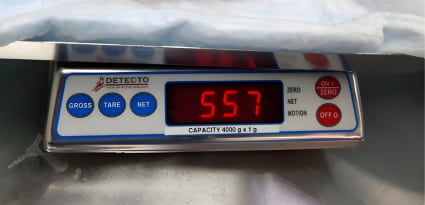
JHAH surgeon removes “huge” prostate weighing more than half a kilogram
Dr. Tareq Al Tartir, Chief of Urology at JHAH, urges men to contact their primary care physician if they are having difficulty urinating.
A surgeon at Johns Hopkins Aramco Healthcare (JHAH) has removed an unusually large prostate from a patient who presented in extreme pain from being unable to urinate.
The prostate, which weighed 557g, is thought to be among the largest removed by a surgeon in Saudi Arabia.
The prostate is a small gland below the bladder that makes semen and controls the flow of urine. In its normal state, it is about the size of a walnut and weighs less than 20g. However, it can become enlarged over time, particularly in men aged over 50.
Dr. Tareq Al Tartir, Chief of Urology at JHAH, who performed the prostatectomy, said that any man having trouble urinating should immediately book an appointment with their primary care physician.
“If you are having difficulty urinating, it could be because of an enlarged prostate,” Dr. Al Tartir explained. “The earlier we catch an enlarged prostate, the lower the risk it will cause complications and pain in the future.
The patient upon whom Dr. Al Tartir performed the prostatectomy had presented at another hospital saying he was unable to urinate. Clinicians there soon discovered that his prostate was abnormally large, and they were forced to insert a catheter directly into his bladder.
The patient was then referred to Dr. Al Tartir for specialist treatment at JHAH.
“He was in agony,” Dr. Al Tartir said. “He needed immediate relief from the pain. So I told him the only course of action was to remove his prostate.”
Within minutes of being admitted, the patient was in the operating room under general anesthetic. Dr. Al Tartir and his team removed the prostate in a surgery that lasted about two hours.
“We decided to go through the capsule of the prostate and remove it step by step, while ensuring there was no bleeding within the capsule by suturing appropriately,” Dr. Al Tartir said. “During the surgery, because of the patient’s cardiac history, we had to shock his heart because it was not acting properly. But apart from that, the surgery went very well.
It was absolutely huge, the largest prostate I’d seen in my career, by a long way. It’s unusual to see them so large because nowadays, enlarged prostates are typically caught earlier.
“Removing a small or medium-sized prostate — one that is up to about 200g — is much easier than removing a large prostate because it typically doesn’t involve open surgery. Anything larger than 200g is more difficult and will often require open surgery, as was the case here.”
The patient was admitted to intensive care for less than 48 hours after surgery. After recovering well, he was discharged in good condition after about three days, meaning his total admission was about five days. He had a catheter for about one month after that.
